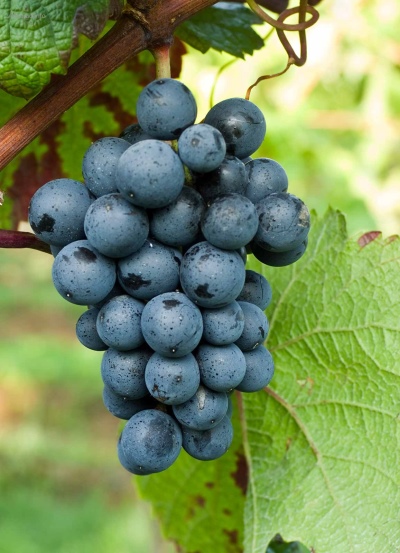
- Authors: Czechoslovakia and Germany
- Appointment: technical
- Berry color: black
- Ripening period: early
- Frost resistance, ° C: -24
- Name synonyms: Gm 6494-5
- Flower type: bisexual
- Skin: durable
- Appeared when crossing: Dawn of the North x Saint Laurent
- Berry shape: rounded
A huge number of specialists have been working on the development of new grape varieties for many years. This is due to the fact that the fruits of this plant can be used in the preparation of various dishes, to obtain wine or raisins. The Rondo variety is a vigorous plant that is characterized by an early ripening period.
Breeding history
Rondo is considered to be one of the technical grape varieties. It appeared in Czechoslovakia and Germany, originally known as Gm 6494-5.
The cultivation of this grape was originally carried out by Dr. V. Kraus. After short work, he invited Dr. Becker to take up breeding work. Rondo was officially patented in 1997.
Description
A vigorous plant is characterized by the fact that the first berries appear in mid-August. There are several main advantages.
Good frost resistance.
Early ripening.
Resistant to mildew.
The leaves are large in size, have a green tint with yellow tints. The vine ripens completely in one season.
Ripening period
The popularity of the variety in question is associated primarily with the early ripening period. The first berries ripen in early August under favorable conditions.
It takes about 130 days from the swelling of the buds to the full ripeness of the berries. In most cases, berries are picked at the end of August.
Bunches
The resulting clusters have a conical shape. The maximum weight of one bunch is not more than 300 g.
It should be borne in mind that the berries dry out very quickly. Therefore, it is necessary to collect the berries in a timely manner, otherwise they will quickly fall off.
Berries
The resulting berries are relatively small, mostly round in shape. The skin is firm, blue in color, with a shimmer.
The berries are very densely located. At the same time, they are not subject to decay, but they fall off if the harvest is not carried out in a timely manner. The berries weigh up to 3 g.
Taste
Attractive taste has become the reason for the spread of this variety. Sugar content up to 21%, acidity 10 g / l.
Many people rate the taste at 4 points. These grapes can be used to make various drinks.
Yield
Fruiting takes place within two or three years. Ripening of the vine is carried out at 6/7 of the length. The yield indicator is average. The optimal load is 3-5 eyes.


Growing features
Among the features of cultivation, one can note the need for periodic pruning and fertilization. This is due to the vigor of this plant.
Fertilization should be done during the growing season and after harvest. This is due to the fact that the plant requires a lot of energy to form fruit even before the onset of frost.
Landing
Planting the plant in question should be carried out taking into account all the recommendations.
Disembarkation is carried out in spring or autumn.
Before performing the work directly, you need to inspect the root system, it must be white and not damaged.
The depth of the holes created should be twice the length of the roots of the seedlings.
For the grapes in question, a support is required; at the first time after planting, a wooden peg is used.
Immediately after planting, you need to pay attention to timely mulching and systematic watering. Grapes do not tolerate drought well.

Pollination
There are no major problems with pollination of this variety. This is due to the presence of flowers of both sexes.
The main requirement for good indoor pollination is to create a slight breeze. For this, windows are covered or fans are installed. Otherwise, the pollen does not move well.
Pruning
You need to prune in the second year after planting. It is recommended to leave only 5 eyes, as otherwise the plant will not have the proper amount of nutrients for the formation of berries.
Preventive pruning is carried out before the immediate onset of cold weather. At this stage, damaged areas and remaining leaves are removed.



Frost resistance and the need for shelter
The frost resistance index is average. The vine can withstand frosts down to –24 degrees Celsius. However, prolonged exposure to frost causes the death of the plant.
There is a need for shelter for the winter period. This can be done by removing the vine from the support, after which preventive pruning is performed, the creation of a frame structure and its cover with dry foliage.

Diseases and pests
The increased resistance to mildew determines the wide distribution of the variety. However, it is more susceptible to chlorosis.
The plant can be attacked by ticks. It is quite difficult to deal with them, since after the appearance of several individuals, the colony spreads quickly. Moreover, the appearance of new individuals is not associated with the time of the year or the weather.

If the grapes are exposed to any disease or insect, this is always reflected in its appearance.
Storage
As previously noted, harvest should be done immediately after ripening. Berries are stored at temperatures up to 4 degrees Celsius for one week. On the branches, they quickly lose their moisture, shrink and crumble.
The variety in question, because of its taste, is most common among winemakers.











































































